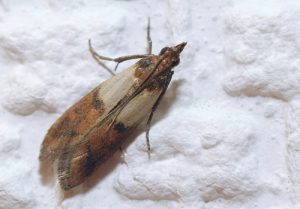Indian Meal Moths
By Chris Williams on April 25, 2011.
Q. I found what looks like webs inside a cereal box, and sometimes find little moths flying around. What’s going on and what should I do?
A. Webs in cereal boxes or other stored grain products usually point to the Indian meal moth. Small moths flying around the kitchen or sitting on walls near the pantry are the adult Indian meal moths. This widespread pest of stored food prefers the coarser grades of flower and is the most common pest in wholewheat, and cornmeal (Indian meal). Feeding is not confined to grains, it is found outside in a wide variety of substrates including ear corn, wild grasses, and nuts. Inside the home Indian meal moths have been found infesting grain products and broken grain, seeds, stored bird seed, nuts, dried fruits, dried flowers, crackers, pasta, biscuits, dried soup mixes, cake mix, muffin mix, powdered milk, spices, chocolate, candy, dried red peppers, and pet food. Once I found a bag of cat litter made from wheat completely infested with hundreds of moths, larvae, and webbing. The only place in the house with lots of activity was the upstairs bathroom. My inspection found the wheat cat litter in the back of the bathroom closet under a pile of bathroom supplies, forgotten.
Adults have a wingspan of about 20mm. Wings are pale grey in color with the outer portion a reddish brown. While at rest the wings appear to have a light stripe behind the head. After mating, females deposit eggs on or near a food source. Egg laying takes place at night. Each female may lay up to 400 eggs in about 18  days, separately or in groups. After hatching, the tiny white larval caterpillars glue themselves into cracks and crevasses of the food material. The larvae are generally dirty white but may vary in color depending on the color of the food source. The size of the larvae also depends on the quality of the food source. With a life cycle ranging from 27 days to more than 300 days depending on conditions, 4-13 generations may occur and overlap during a single season. Temperature and the quality of the food source determine the developmental time span. Surrounded by a case of silky webbing with food particles mixed into it, the larvae contaminate much more food than they can consume. This webbing material often extends throughout the food material and is visible when looking into infested packages. The larvae crawl out of the food material to pupate. Sometimes traveling far away from the original food source along walls and into other cabinets, the larvae spin small silken cocoons in which to pupate (turn into adult moths). Pupation allows the larval caterpillars to transform into adult moths, similar to the way Monarch butterfly caterpillars form a chrysalis. Upon emergence, mating takes place and the cycle begins anew.
days, separately or in groups. After hatching, the tiny white larval caterpillars glue themselves into cracks and crevasses of the food material. The larvae are generally dirty white but may vary in color depending on the color of the food source. The size of the larvae also depends on the quality of the food source. With a life cycle ranging from 27 days to more than 300 days depending on conditions, 4-13 generations may occur and overlap during a single season. Temperature and the quality of the food source determine the developmental time span. Surrounded by a case of silky webbing with food particles mixed into it, the larvae contaminate much more food than they can consume. This webbing material often extends throughout the food material and is visible when looking into infested packages. The larvae crawl out of the food material to pupate. Sometimes traveling far away from the original food source along walls and into other cabinets, the larvae spin small silken cocoons in which to pupate (turn into adult moths). Pupation allows the larval caterpillars to transform into adult moths, similar to the way Monarch butterfly caterpillars form a chrysalis. Upon emergence, mating takes place and the cycle begins anew.
Indian meal moths may become introduced to a home in many ways. Every aspect of production, storage, transportation, and distribution gives this opportunistic pest a chance to get a foothold. From the field to the grocery store and every place in between the Indian meal moth may be present. Indian meal moth populations exist outside in nature and adults may enter a house in their search for suitable larval food sources. Once established, Indian meal moth populations can explode quickly. Action should be taken at the first sign of infestation. Thorough inspection of all potential food sources in all areas of the structure and removal of infested and suspected infested packages is the first step. Cleaning of spilled food material, pet food over flow, flour build up or other potential substrate is also important, as eggs may be laid on small amounts of suitable material. Pupal cocoons should also be removed, household cleaning solutions will wash them off walls and out of cracks. Pest Control Professionals may use direct contact insecticides to knock down adults flying around. Growth regulators may also be used to break the cycle of development. The main control method is removal of infested food products, and cleaning suspect areas. If this fails to control the situation, Pest Control Professionals can take a look and make specific recommendations relevant to your unique situation. You do not have to live with Indian meal moths in your kitchen.